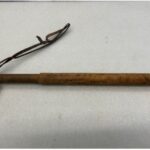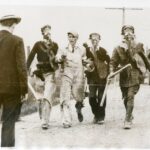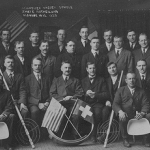As the effects of the 1929 Wall Street Crash and the Great Depression rippled through the United States, many working-class Americans felt the economic impacts, including Wisconsin’s farmers. Midwestern farmers were already suffering even before the Depression, and since Wisconsin served as the nation’s leading producer of many different dairy products, the livelihoods of many farmers and workers depended on the dairy industry. However, the yearly average price received by Wisconsin farmers for milk dropped from $2.01 in 1929 to $0.89 in 1932, a decrease of 56 percent in just three years. Farmers could barely afford to cover the production costs for dairy products and felt that their demands were not being heard by Wisconsin state officials. Angry and desperate at the decreasing price that they were receiving, many of Wisconsin’s farmers, producers, and shippers joined a series of three strikes in 1933, colloquially known as the Wisconsin Milk Strikes.
In order to alleviate the burden brought on by the Depression, many of Wisconsin’s farmers and producers began participating in local and statewide cooperatives. These organizations merged independent, rural producers into larger collective structures, which also served as political advocacy groups for farmers’ rights. Many cooperatives helped lead the strikes, especially the Wisconsin Cooperative Milk Pool, led by President Walter M. Singler. The Milk Pool formed in 1932 as a statewide organization, and Singler quickly gained a reputation for his charisma, powerful appearance, and fiery debating style. While the Milk Pool had a much smaller membership than its contemporaries, Singler’s energy and determination quickly solidified them as an important labor organization.
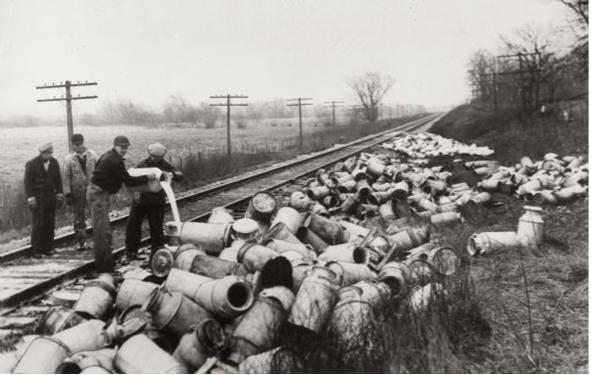
For many desperate farmers, Singler’s confident rhetoric was magnetic. The farmers most impacted by the Depression were small producers, mostly located in eastern Wisconsin. These farmers could not afford the cost of production for milk and felt neglected and unheard by the Wisconsin and federal governments. On February 8, 1933, Singler and the Milk Pool leadership voted to launch a state-wide strike for February 15. The Milk Pool hoped that large-scale walkouts, a withholding of dairy products from the market, and even a direct disruption of dairy production would create a shortage that would raise the base price of milk. While Singler gained a sizable base during this strike, it was largely unsuccessful. Many of the organizations and cooperatives that participated in the strike grew angry with the lack of results and threatened to pull out of the strike. With mounting internal and external pressure, Singler reluctantly ended the strike and called a truce with Wisconsin Governor Albert G. Schmedeman after a heated and long meeting in Madison on February 22. However, many farmers remained agitated by the dairy situation and felt willing to follow Singler in the future.
On April 11, the Milk Pool organized a meeting in Appleton, hosting representatives from cooperatives and labor unions across the state, the Midwest, and the nation. One of these organizations was the incredibly large and influential National Farmers’ Holiday Association, led by Milo Reno. At this meeting, the group reiterated their list of demands to national and state officials. The group called on the legislature to set a base price for milk, provide relief from mortgage foreclosures through the Frazier Bill, and reduce debts and guarantee farmers the cost of production for dairy commodities through the Swank-Thomas Bill. During the discussions, Singler’s Milk Pool often butted heads with larger organizations like the National Farmers’ Holiday Association and the Wisconsin Farm Holiday Association. Each of these organizations boasted over 100,000 members, compared to Singler’s 10,000-11,000. The power dynamics based on membership and other disparities led to many internal disagreements between the cooperatives about the best course of action for the strikes. Despite these differences, the group of cooperatives issued an ultimatum to the state legislature: meet the demands of farmers or face a second strike.
On May 12, Singler declared the start to the second strike, yet immediately faced serious obstacles. At the last minute, Milo Reno pulled the large Holiday Association and its members out of the strike, choosing to instead encourage negotiations with Schmedeman. Additionally, Schmedeman passed harsh collective punishments on any county that embargoed milk. Due to these county-wide restrictions and punishments, only 19 counties out of the 71 in Wisconsin completely closed for the delivery of milk. Despite these obstacles, the Milk Pool persevered, organizing mass protests and strikes across the state. Like the strikes in February, workers attempted to create a shortage of milk by disrupting production and shipping and also declared countywide embargoes on milk, hoping this would raise the price of dairy products. But this time, the second strike had a larger base of support from local, statewide, and national cooperatives. Schmedeman attempted to make concessions with the cooperatives, including the Milk Pool, on the condition that Singler be ousted as President. However, farmers felt increasingly desperate and angry, and violence broke out in some of the poorest parts of the state where the milk pricing was the lowest. This included Shawano County, Waukesha County, and Outagamie County. Farmers began raids on dairy production plants and milk shipments, dumping the barrels of milk that they intercepted. This prompted immediate action from Schmedeman and Wisconsin state officials, who mobilized the Wisconsin National Guard to assist local law enforcement to suppress the more militant strikes. When deployed, the National Guard utilized firearms, tear gas, and blunt nightsticks to break up the strikes by force. While more successful than the first at raising milk prices, the second strike made marginal progress in improving farmers’ overall situation.
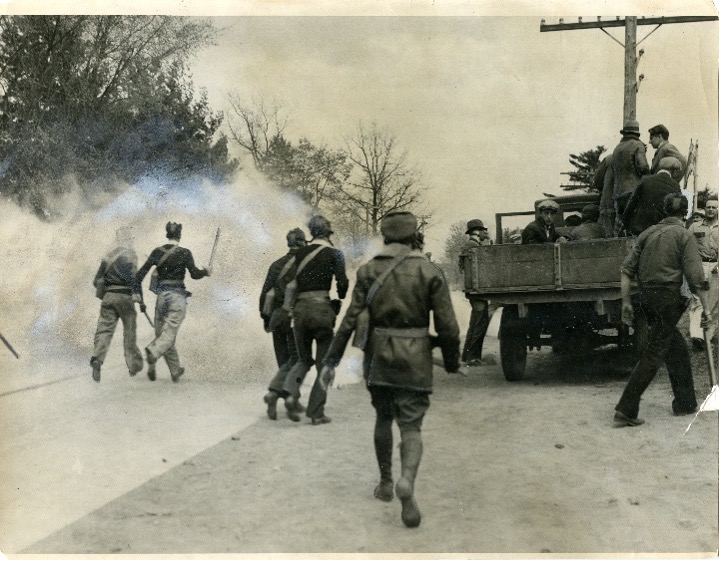
While some labor organizers and cooperatives began to negotiate with Schmedeman and the Wisconsin legislature, many farmers remained agitated. Although the May Milk Strike briefly increased milk prices for farmers, prices immediately decreased in the months following the strike. Farmers felt defeated and questioned whether their previous efforts made any impact on improving their situation or making their voices heard. Additionally, Schmedeman began publicly slandering Singler during this time, painting him as a demagogic agitator that was influenced by Bolshevism and foreign interests, inflating Red Scare fears among the public due to the American government’s anti-communist and anti-union stance at the time. While Singler denounced the violence of the strikes in May, Schmedeman attempted to hold him personally responsible for the actions of farmers. However, Singler’s base continued to grow, and a third strike broke out on October 21. Organized by Reno’s Holiday Association and the Milk Pool, this strike initially had a large base of support. A more militant strike, farmers targeted production plants and creameries with bombings. This included the bombing of creameries in Krakow and Zachow, located in Shawano County. The strike was called off in November, as Schmedeman agreed to make additional concessions to the farmers. As part of the deal, Schmedeman organized an agricultural committee to investigate the milk pricing situation, appointing multiple Milk Pool members to participate. However, it would take federal action by the Roosevelt administration to truly improve the standard of living of Wisconsin farmers.
While the Milk Strikes largely failed to immediately improve the struggles of Wisconsin’s farmers, the New Deal programs passed by President Franklin D. Roosevelt helped improve their standard of living. Nevertheless, the strikes demonstrate the resilience of many of Wisconsin’s farmers in the face of economic hardships. Despite the division that the strikes created, farmers persevered through these times and found unity through cooperative structures and labor organization
Written by Nick Censoprano, June 2023.
SOURCES
Hoglund, A. William. “Wisconsin Dairy Farmers on Strike.” Agricultural History 35, no. 1 (1961): 24–34. http://www.jstor.org/stable/3740991.
Jacobs, Herbert. “The Wisconsin Milk Strikes.” The Wisconsin Magazine of History 35, no. 1 (1951): 30–35. http://www.jstor.org/stable/4632334.
White, Ann Folino. “Milk Dumping across America’s Dairyland: The May 1933 Wisconsin Dairymen’s Strike.” In Plowed Under: Food Policy Protests and Performance in New Deal America, Indiana University Press, 2015, 64–111. JSTOR, http://www.jstor.org/stable/j.ctt16gz9pk.6.
Wisconsin Co-operative Milk Pool. “Wisconsin Co-operative Milk Pool Records, 1928-1943.” Wisconsin Historical Society, Division of Library, Archives, and Museum Collections. Finding Aid: http://digital.library.wisc.edu/1711.dl/wiarchives.uw-whs-mss00026
“Pickets on Some State Roads; No Trouble Reported.” The Wisconsin State Journal. 13 May 1933. p. 1.
“Pool Votes Farm Strike Ultimatum.” The Wisconsin State Journal. 12 April 1933. p. 4.
“Reno Delays Strike, Plans New Session.” The Wisconsin State Journal, 13 May 1933. p. 1.
“Singler Told To Stay Away.” The Manitowoc Herald Times. 16 May 1933. p. 1.
“Wisconsin Group to Go Ahead.” The New York Times. 13 May 1933. p. 3.
